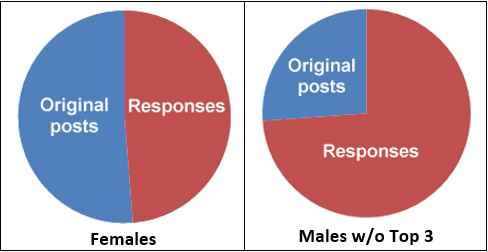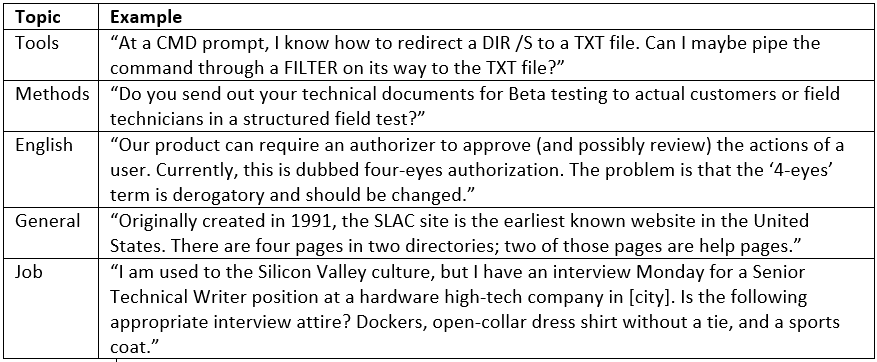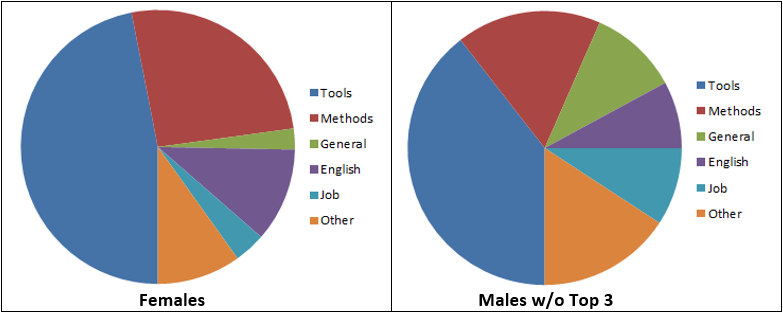 Long story short, I’m finishing my Bachelor’s degree a mere 32 years after my expected graduation date. (You know how it gets with deadlines…) For my senior research project, I decided to write a paper about something I actually know a little about, namely TECHWR-L. But I mixed it with something I know almost nothing about, namely gender communications. I downloaded 800 TECHWR-L posts from a period of several years and I asked four questions:
Long story short, I’m finishing my Bachelor’s degree a mere 32 years after my expected graduation date. (You know how it gets with deadlines…) For my senior research project, I decided to write a paper about something I actually know a little about, namely TECHWR-L. But I mixed it with something I know almost nothing about, namely gender communications. I downloaded 800 TECHWR-L posts from a period of several years and I asked four questions:
“Why is this night different…“ – no, wait, wrong list. Here they are:
- How do the genders differ in the balance between starting and responding to threads?
- How do the genders differ in responding to posts from the same gender or the other gender?
- How do the genders differ in starting new threads in specific topic areas?
- How do the genders differ in their use of language?
Let me start out with a few caveats, or as I like to call them, “bogosities.” (That’s a Googleyup, in case you were wondering.) One bogosity is that I used my own biases and horse sense to assign genders to the posting Whirlers. I assumed, for example, that Chris Morton is Christopher and not Christine.
 Another bogosity is that I set aside three posters who were so prolific as to skew the data:
Another bogosity is that I set aside three posters who were so prolific as to skew the data:
The top three posters (all of them males) comprise only 2.2% of the posters but account for 43.6% of the total posts. If you look at the report in detail, most of the data tables examine “all males” separately from “males without top three.”
I should also mention one major non-bogosity, which is the invaluable assistance provided by Mitch Maltenfort. Mitch not only determined which data were statistically significant but also suggested additional data to look for (more about that later).
Anyway, for the first question, a picture is worth several dozen words:

How about that? Around half of the posts by females are original posts, but only about one-fourth of the posts by males (minus the top three) are original posts.
My second question, like the first one, came up with a statistically significant answer. Male Whirlers receive a lot more responses to their original posts than female Whirlers do:

In case you were wondering, this isn’t about men responding to men and women to women. Male posters receive more responses from male and female responders.
Third question – I got nada. I found no statistically significant difference between the topics chosen by females and males when they start a new thread with an original post. I looked at nine categories of topics, but for both genders, the same five were the most popular:

Or if you want to pie it:

Someone might ask: But if females and males write original posts about the same topics, why do the males receive so many more responses from both genders? Good question! But I’m only providing questionable data here; I don’t claim to be wise enough for Whys.
Finally, for the fourth question, I got nearly nada. (Let’s say, I got a rock.) I first compared female and male use of what’s known as tentative language, which includes hedges (“I guess,” “pretty much”) and tag questions (“Don’t they?” “Isn’t it?”). Tentative language has been studied to death in gender communications, but I found no statistically significant difference between female and male Whirlers’ use of tentative language.
As an alternate approach, Mitch suggested looking at the use of the word “Thanks,” which has a solid basis in research: One study found that in e-mail correspondence at an educational organization, women were nearly twice as likely as men to conclude their messages with a farewell formula (e.g., “Thanks”) accompanied by their name, as opposed to concluding with just their name. (The same study found no such difference in e-mail correspondence at a manufacturing plant.)
In my study, there was some difference between female and male use of “Thanks,” not enough of a difference to be statistically significant – but close. Mitch suggested that a larger sample size might have pushed that one over the edge into significance.
So there you have it: Ms. Poster and Mr. Responder on TECHWR-L. For anyone who’s interested, the full report, Gender Study of TECHWR-L Postings is here. I’m happy to get feedback from anyone, although I suppose I’m most likely to hear from the Top Three Posters. It was just a small project for school, and I realize that “statistically significant” is not the same as “important.” All the same, it was fun to put the mice through a familiar maze.